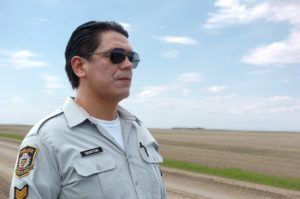Opinion: Stoic: A look at Indigenous masculinity

By Keith Corbiere
Tommy Orange said it best in his literary award winning 2018 novel, There There:
“That dance is your prayer. So don’t rush it, and don’t dance how you practice. There’s only one way for an Indian man to express himself. It’s that dance that comes from all the way back there. All the way over there. You learn that dance to keep it, to use it. Whatever you got going on in your life, you don’t leave it all in here, like them players do when they go out on that field, you bring it with you, you dance it. Any other way you try to say what you really mean, it’s just gonna make you cry. Don’t act like you don’t cry. That’s what we do. Indian men. We’re crybabies. You know it. But not out there.”
The character to utter this is Bobby Big Medicine, a “big, maybe six-four, three-fifty” behemoth of a man who appears in the novel as the magnetic and golden-voiced leader of an Oakland, California drum group. When I first read these words early last year, I was astounded by the candor of Orange in his writing, and nearly knocked over by how much I related to the quote. Like many other Indigenous men my age, I had always felt a fundamental disconnect from the paradigm of the sober, unemotional, gristle-tough Indigenous man plastered all over popular media, and I was suddenly faced with a representation, a truth, that I immediately identified with.
Indigenous men are presented with the brooding and reserved facsimile of an Indian who may have been typical decades in the past. The first example for many of us may have been Chief Bromden in Ken Kesey’s classic 1962 novel, One Flew Over the Cuckoo’s Nest (or its 1975 film adaption). Although a complex and emotionally nuanced character, the Chief is a perfect example of the surface standards used to define even modern Indigenous men: angular, strong, serene, and thoughtfully silent. In the case of Bromden, his moniker was even the Chief. The Chief is developed throughout the novel to be more than the sum of his clichéd parts, but the clichés permeate his character nonetheless. A more modern example is borne from Noah Hawley’s Fargo, airing in 2015. Hanzee Dent (played by the talented half-Lakota, half-Irish actor Zahn McClarnon) is an enforcer and foot soldier for the local mob in the second season of this acclaimed television adaption. While undeniably compelling, the character of Hanzee still subscribes to the same decrepit, steadfast tropes worn by the Chief 50 years ago: angular, strong, serene, and thoughtfully silent. This also applies to the Tontos, the Kocoums, and the Magical Medicine Men in modern fiction. To many Indigenous men, it seems as though these qualities are the go-to when it comes to writing Indigenous male characters, and in turn, we wish to emulate these qualities, subconsciously or not, when it becomes the only representation available.
However, this isn’t to say that there aren’t some exceptions within the leagues of banal stereotypes. As I’ve stated in a previous article, one of my favourite depictions came in the figure of Parks and Recreation’s Ken Hotate (played by Jonathan Joss), a humorous and versatile portrait of a modern Indian chief. Tommy Orange’s There There examines a multitude of Indigenous males free from the restraints of traditional clichés, including a basement-dweller in Edwin Black, an urban filmmaker in Dene Oxendene, or a struggling janitor in Thomas Frank. And perhaps my favourite fictional Indigenous male comes in the character of Sergeant Davis Quinton (played by Lorne Cardinal) on CTV’s Corner Gas. Unlike so many other Indigenous characters, in which their culture is their character, Davis’ heritage is only a small and trivial aspect of who he is as a person. Davis is a reader of Cosmo, a sci-fi fanatic, a former rhythmic gymnast, and a Hardy Boys devotee. He is oversensitive and earnest. And underneath it all, he happens to be a member of the Cree Nation. Growing up, this was the fictional Indian I identified with the most; the one who laughed, and cried, and managed to be something other than just ‘another Indian’.
More often than not, Indigenous men in fiction are shoehorned into the same familiar mould. My father is one of the most emotional men I’ve ever met; my uncle, on the other hand, may be the most stoic. Like the men (or women) of any culture, Indigenous men are a wide and diverse group, with personalities ranging from rigidly taciturn to wildly emotive. I believe it is time that the shows and movies we watch, the video games we play, and the content that we consume changes to reflect this.
While I celebrate minorities the world over for breaking old cultural norms and defying useless expectations, I can’t help but think of the many Indigenous characters in popular media who could be doing the same – but just need to be written a little better. When the next generation of young Indigenous men are consuming TV and film, I earnestly hope they can see fewer Chiefs and Hanzees, and many more Davis Quintons.


